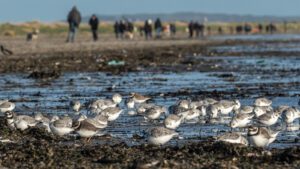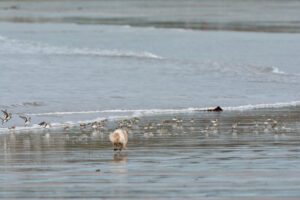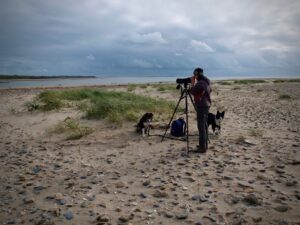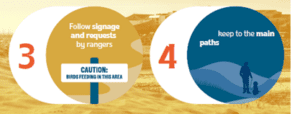By Lesley Lewis
Many of us love the vast expanse of our shorelines, with plenty of space for our dogs to run freely. But it is time to stop and think seriously about the damage that this causes, and to learn to responsibly ‘share the shore’ with the animals that make it their home.
Understanding waterbird disturbance
We often refer to ‘disturbance’ as being a pressure upon our wintering waterbirds, with the likelihood of negative impacts if the pressure is great. So why is disturbance an issue and why are we ever more worried about increasing levels of disturbance as a result of increasing recreational use of waterbird habitats? Well, this article aims to explain why it is an issue of concern. In addition, we wonder if there are some common misconceptions when it comes to our interactions with birds. This article aims to debunk those myths.
Ireland’s population size is growing and with many of our towns and cities located beside major wetlands such as Dublin Bay, Galway Bay, and Cork Harbour, increases in housing and population size are leading to increased use of our coastal (and inland) wetlands for recreational purposes.
It is estimated that over 2 million people visit North Bull Island each year, yet Bull Island is also home to thousands of wintering waterbirds each autumn and winter. Understanding their needs is crucial to understanding how we can use this space without harm.
Bull Island and Dollymount Strand – Where human recreational use and important waterbird habitats collide. (Photo: John Coveney)
Myth: Walking along the shore doesn’t cause any harm
Well actually it might. Disturbance can be defined as any activity that causes a bird to be displaced from where it was. Many activities along our shorelines and inland wetlands have the potential to cause disturbance to waterbirds. These may include shore-based activities such as walking or running with or without dogs being present, the presence of vehicles along the shoreline and water-based activities such as power boats, jet skis, kite surfing and others. Recent research also shows how the use of drones near waterbird sites can have negative effects on waterbirds. And don’t forget that birdwatchers and photographers can cause disturbance too! It’s not always about the type of activity, but where it takes place.
Myth: Birds can simply fly away from sources of danger
Well yes, they can fly away, but it really isn’t that simple. We welcome hundreds of thousands of waterbirds to Ireland during autumn and winter. These birds have one sole aim during winter – to rest, feed, and be in as good a condition as possible to make their migratory journey back to their breeding grounds in spring. They need to be healthy enough on arrival to breed and produce new young members of the population. Simply put, the birds must eat enough during winter to survive and thrive. But what happens when the birds are constantly disturbed? Moving away from the source of disturbance, be it through walking, swimming, or flying, uses energy, and vital energy reserves are wasted when flying around trying to find other spaces. Flying away wastes precious time that could have been spent feeding or resting.
Myth: There is plenty of other space
In reality, this is not the case. Our shorelines can look large and expansive with plenty of space for both people and birds. But we need to be careful to allow waterbirds to use the spaces they need. This is because not all areas are of equal value to birds. Waterbird distribution is not random; they actually distribute according to many factors but most important during winter, is the need to feed. Waterbirds ideally forage in areas where their prey is both accessible and plentiful, with different species adapted to feed upon differing prey to reduce the risk of competing with each other for the same food. So different waterbird species will be in different places for a reason.
Being forced to move due to disturbance results in the birds moving to areas where the ‘larder’ is not as full, or where there are many more birds competing to eat the same prey. The outcome of disturbing foraging waterbirds is that their vital energy intake during winter and body condition may be reduced. Some birds may simply not be able to find enough to eat! Can this affect our population levels? – Yes it can! Going hungry means that over-winter survival may become a real issue, and if birds do not survive the winter or cannot make their migratory journey back to their breeding grounds in a healthy enough condition to breed, then numbers of these waterbirds will decline.
Myth: It is okay to walk or run through a flock of birds
We often see people walking along the tideline and straight through a flock of birds. Even a slight detour could leave the birds in peace. Would you barge through a group of people sunbathing or picnicking on the beach? Then why walk through a group of resting or feeding birds? Waterbirds need safe and secure roosting locations, places where they can rest and sleep, during both day and night. Greater use of our shorelines is leading to the number of safe, secure roosting sites becoming increasingly limited. Like foraging places, roost sites are not random, and birds choose areas where they can rest safely, often close to water, and where the perceived risk of predation is low. Many waterbirds are ‘faithful’ to their roost sites meaning that the same place is used several times daily, and in fact, every winter when the birds return to our shores. Being ousted from these places sometimes mean that the birds have to fly around looking for somewhere else suitable to rest; but what if there is nowhere suitable to go?
Myth: Birds enjoy being chased by dogs
No, in fact, it must be quite terrifying for them. Can you imagine what it would be like to be chased by a predator ten times your size? Waterbirds perceive dogs as potential predators. Even a dog walking by on a lead can cause a change in behaviour as the birds increase their time spent assessing the danger, instead of feeding. The more dramatic response of birds flying away in alarm has obvious implications in terms of lost foraging time and wasted energy reserves. If the disturbance continues, this can lead to the birds completely avoiding, and potentially losing, part of a site that was important in terms of food resource. Science also tells us that the effects of being chased can be far-reaching. A faster heart rate and rise in body temperature can cause the bird to use up more energy initially, with the potential for longer-lasting physiological effects such as a change in hormonal levels.
To help think about the issue from a bird’s perspective, watch this interesting video from the Wadden Sea World Heritage ‘You are a guest – this is where I live’.
Myth: They don’t mind, they’re used to it
Indeed, some waterbirds get used to activities occurring along the shores, but this ‘habituation’ varies widely for different sites and different waterbird species. Birds within a highly disturbed area are likely to show a higher degree of habituation than birds wintering at secluded sites where few activities occur. It’s really important to bear this in mind when visiting shorelines during winter and to not make general assumptions from bird behavioural responses you’ve seen before. Furthermore, just because they’re used to humans, doesn’t mean we’re not stressing them out.
A dog chasing a flock of wading birds. (Photo: Richard Mills)
But dogs don’t always have to spell danger – being under control is key. Lesley, on the I-WeBS (Irish Wetland Bird Survey) Team, had an amazing eight years with the gorgeous survey companion Ruby, who along with Kenny, was trained to sit beside the telescope during waterbird surveys. Lesley explains further ‘they still got to have some fun and exercise, but they were only left run and play in quiet areas where there were no birds. But they were happy too, sitting and guarding me during the bird counts. Plus, they were the best companions. There is never a reason to allow your dogs to chase birds’.
Photos: Lesley Lewis with her survey companions. (Top – Lesley Lewis; Bottom – Matt Dillon)
And what about breeding waterbirds?
Many waterbirds nest along shorelines including Oystercatchers, Ringed Plovers, and terns, to name a few, and these need our consideration too. People walking along a shoreline may walk too close to a nesting site and this could frighten adult birds away from their eggs or chicks. This can leave their young vulnerable to being eaten by gulls or crows or getting crushed underfoot. It is good to be aware of signs that could indicate nesting shorebirds and the vulnerable time is between mid-April and end of August each year. For example, the adults may circle noisily overhead with defence calls to alert the chicks, while terns may dive-bomb people that get too close. Being mindful of such behaviours may stop you from getting too close and trampling the well-camouflaged eggs or chicks. Please be respectful of fencing or signage that aims to prevent people from encroaching into these areas, and it is really important at this time of year to keep dogs on a lead.
For more information, read more about the Kilcoole Little Tern Project here to learn how we work with local people and volunteers to protect Ireland’s smallest tern, the Little Tern at Kilcoole Beach in Co. Wicklow.
How can we safely share the shore with waterbirds?
Galway City Council have launched the ‘Share the Shore’ Campaign’ .
Galway City is a dog-friendly place and the citizens of Galway City have been actively participating in recent initiatives such as the ‘Clean it up you dirty pup!’ 2021 campaign to tackle dog litter in Galway City. Now again, we are calling on the dog owners of Galway City to help protect our vulnerable coastal birds. Dogs love the coast and life doesn’t get much better for our dogs than having a run and a good sniff along the beach. It makes them happy which makes us, their owners, happy too!
However, dogs have a big part to play in helping our wintering waterbirds. Galway Bay is known to be one of the best ornithological areas in the western region. It supports a huge diversity of wintering waterbirds with divers, grebes, cormorants, ducks, swans, geese and waders. Our wading birds (or shorebirds) are amongst the most threatened of all birds in Ireland, with significant declines since the 1990’s.
Research shows that well over 50% of coastal bird disturbance involves a dog, mostly involving dogs which are off lead. Dogs themselves are not doing anything wrong, they are doing what comes naturally and following their instincts. But they need our help to do the right thing. If your dogs can do the following four simple things, then this will help our waterbirds enormously and your dogs can still have fun.
Dog Rangers
Galway City are looking for dogs to join their team of Dog Rangers! They are an essential part of their service as they help to spread the message about waterbird conservation and set a brilliant example for other dogs on the beach. If you would like to get involved, please contact parks.department@galwaycity.ie. They will feature Dog Rangers on our social media channels and more information can be found on their website.
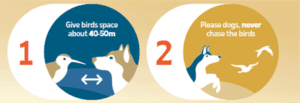
Infographic: Galway City Council.
- Give the birds space. Around 40-50 metres should be fine under most circumstances but it does depend on whether you are running around or just plodding along! If the birds fly off you have got too close – give them more space next time. For example, you could walk along the upper shore, giving space to the birds on the lower shore.
- Never encourage or let your dog chase birds. Your dog might think it is fun but birds don’t think it’s a game – it’s life and death to them as it wastes valuable energy and gives them less time to feed.
- Allow the birds to rest. At high tide, wading birds have very little space as their feeding grounds are covered by the rising water. They gather in high tide roosts on upper shores, rocky headlands and man-made structures like piers. Similarly at low tide, you will often see flocks of birds roosting along the shore. These birds may be digesting their food and simply taking a rest. Please be extra careful to give space to roosting birds.
- Follow signage and Council requests. The signs may be alerting you to the presence of waterbird feeding or roosting areas. During the breeding season the signs will help you to avoid areas where species are nesting. In some areas you may be asked to have your dog on the lead. We promise to ask you this only when it’s essential to avoid harming the waterbirds.
Share the shore, enjoy the shore and enjoy the wildlife!
[Header image: A dog chasing waterbirds – this might be fun from a dog’s perspective but not from a waterbird’s perspective. Photo: Richard Mills.]


